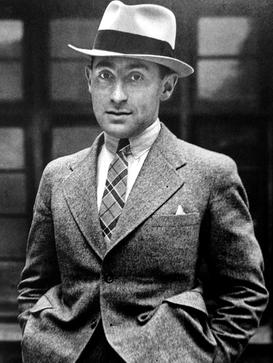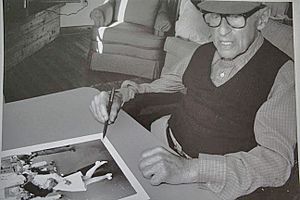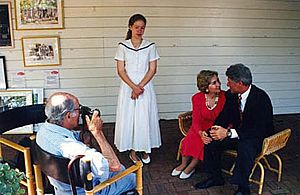Alfred Eisenstaedt facts for kids
Quick facts for kids
Alfred Eisenstaedt
|
|
|---|---|

London, 1932
|
|
| Born | December 6, 1898 Dirschau, West Prussia, German Empire (now Tczew, Poland)
|
| Died | August 23, 1995 (aged 96) |
| Occupation | Photojournalism |
| Spouse(s) | Kathy Kaye (1949-1972; her death) |
| Military career | |
| Allegiance | |
| Service/ |
Imperial German Army |
| Years of service | 1914—1918 |
| Battles/wars | First World War (WIA) |
Alfred Eisenstaedt (born December 6, 1898 – died August 23, 1995) was a famous German-American photographer. He was known for taking pictures for newspapers and magazines, a job called photojournalism. He started his career in Germany before World War II. Later, he moved to the U.S. and became a main photographer for Life magazine.
More than 90 of his photos appeared on the cover of Life. Over 2,500 of his photo stories were published inside the magazine. One of his most famous pictures is V-J Day in Times Square. It shows a sailor kissing a nurse in Times Square on V-J Day in 1945. This photo captured the happiness many Americans felt when the war ended. Eisenstaedt was famous for taking memorable pictures of important people. He often used a small 35mm Leica camera and natural light.
Contents
Early Life
Alfred Eisenstaedt was born in 1898 in Dirschau, which was then part of Germany. Today, this place is called Tczew and is in Poland. His family was Jewish and moved to Berlin in 1906.
Alfred loved photography from a young age. He got his first camera, an Eastman Kodak Folding Camera, when he was 11. He later served in the German Army during World War I and was injured in 1918. In the 1920s, while working as a salesman, he started taking photos as a freelancer. This meant he took pictures for different companies. In 1928, he began working for Pacific and Atlantic Photos in Berlin. This office was later taken over by the Associated Press in 1931.
Becoming a Professional Photographer

In 1929, Eisenstaedt became a full-time photographer for the Associated Press in Germany. People quickly saw how talented he was. He also worked for Illustrierte Zeitung, a magazine published by Ullstein Verlag, which was a very large publishing house at the time.
Four years later, in 1933, he photographed the first meeting between important leaders, Adolf Hitler and Benito Mussolini, in Italy. Other famous early photos by Eisenstaedt include a picture of a waiter at an ice rink in St. Moritz in 1932. He also took a photo of Joseph Goebbels at the League of Nations in Geneva in 1933. Goebbels was friendly at first, but he frowned at Eisenstaedt when he learned that Eisenstaedt was Jewish.
In 1935, Fascist Italy was planning to invade Ethiopia. This made Ethiopia a big topic of international interest. While working for Berliner Illustrierte Zeitung, Alfred took over 3,500 photos in Ethiopia.
Moving to the United States
Because his family was Jewish, they faced difficult times in Hitler's Nazi Germany. They decided to emigrate to the United States in 1935. They settled in New York City, where Alfred later became a U.S. citizen.
In 1936, Time magazine founder Henry Luce bought Life magazine. Eisenstaedt was already known for his photography in Europe. He was asked to join Life as one of its first four photographers. Other famous photographers like Margaret Bourke-White and Robert Capa also joined. He worked as a staff photographer for Life from 1936 to 1972. He became very well-known for his photojournalism of news events and celebrities.
During his career with Life, he photographed many famous people. These included entertainers, politicians, artists, and writers. By 1972, he had photographed nearly 2,500 stories. More than 90 of his pictures were on the cover of Life. With Life magazine reaching two million readers, Eisenstaedt's fame grew a lot. His photos were seen as powerful and symbolic. He also worked for other magazines like Harper's Bazaar, Vogue, and Town & Country.
Photography Style
From his early days as a professional photographer, Eisenstaedt loved small 35 mm film cameras. His favorite was the Leica camera. Most news photographers at the time used much larger cameras with flashes. But Eisenstaedt preferred the smaller Leica. It allowed him to work faster and be more flexible. He could capture natural, unposed moments of people in action.
His photos were also special because he usually used natural light. He did not rely on flash lighting. In 1944, Life magazine called him the "dean of today's miniature-camera experts." This style of photojournalism, using a small camera and available light, was quite new then. It also helped Eisenstaedt create a relaxed mood when photographing famous people. This allowed him to capture more natural poses and expressions. He once said, "They don't take me too seriously with my little camera. I don't come as a photographer. I come as a friend."
He learned this style during his 35 years in Europe. He liked taking informal, unposed portraits and long picture stories. Because of his work, Life magazine started using more such photo stories. The magazine became known for showing the world's important people in a new way. Among Life's photographers, Eisenstaedt was most known for his "human interest" photos. These were less about hard news and more about people's lives and feelings.
Even with his gentle approach, getting the right shot could be hard. Anthony Eden, a British politician, did not like being photographed. He called Eisenstaedt "the gentle executioner." Winston Churchill even told him where to place the camera. Once, while photographing Ernest Hemingway on his boat, Hemingway got angry. He tore his shirt and threatened to throw Eisenstaedt overboard.
Martha's Vineyard
Eisenstaedt, known as "Eisie" to his friends, loved his yearly August vacations. For 50 years, he visited the island of Martha's Vineyard. During these summers, he would try new things with his photography. He experimented with different lenses, filters, and prisms in natural light. Eisenstaedt liked the beautiful lighthouses on Martha's Vineyard. He even helped raise money for them through the Vineyard Environmental Research Institute.
Two years before he passed away, Eisenstaedt photographed President Bill Clinton. He also took pictures of his wife, Hillary, and daughter, Chelsea. This photo session happened at the Granary Gallery in West Tisbury on Martha's Vineyard. A picture of this session was published in People magazine in September 1993.
Personal Life and Death
After moving to New York City in 1935, Eisenstaedt lived in Jackson Heights, Queens for the rest of his life. He married Kathy Kaye, a woman from South Africa, in 1949. They did not have children. They were together until Kathy's death in 1972. Until shortly before he died, Eisenstaedt walked daily from his home to his Life office in Manhattan.
Alfred Eisenstaedt passed away peacefully in his bed at age 96. He was at his favorite cottage, the "Pilot House," at the Menemsha Inn. His sister-in-law, Lucille Kaye, and a friend, William E. Marks, were with him. He was buried at Mount Hebron Cemetery in Flushing, Queens.
Famous Photographs
- V-J Day in Times Square
This is Eisenstaedt's most famous photograph. It shows an American sailor kissing a young woman he just met. This happened on August 14, 1945, in Times Square, during the V-J Day celebrations. He took this picture with a Leica IIIa camera. Because events were changing so fast, Eisenstaedt did not get the names of the people. This led to many different people claiming to be the sailor or the nurse. Later, the identities were confirmed as George Mendonsa and Greta Zimmer Friedman.
- Portraits of Sophia Loren
These photos of the actress Sophia Loren show a playful, dignified, and loving feeling.
- Ice Skating Waiter, St. Moritz
This 1932 photo shows a waiter at the ice rink of the Grand Hotel. Eisenstaedt wrote, "I did one smashing picture... of the skating headwaiter. To be sure the picture was sharp, I put a chair on the ice and asked the waiter to skate by it."
- Children at a Puppet Theatre, Paris
Eisenstaedt took this photo in 1963 at the Tuileries Garden. He remembered, "It took a long time to get the angle I liked... The best picture is the one I took at the climax of the action. It carries all the excitement of the children screaming, 'The dragon is slain!' " This photo sold for $55,200 at an auction in 2006.
Awards and Recognition
- 1989: He received the National Medal of Arts. President George H. W. Bush gave him this award at the White House.
- 1999: The Digital Journalist named Alfred Eisenstaedt the 'Photojournalist of the Century'. Dirck Halstead wrote that Eisenstaedt had the most important impact and left the greatest legacy.
- 2020: Eisenstaedt was added to the International Photography Hall of Fame and Museum after his death.
Exhibitions
- Alfred Eisenstaedt: 'Eisie' at 88, International Center of Photography, New York City, 1986. This was a show looking back at his work.
Alfred Eisenstaedt Awards for Magazine Photography
Since 1998, the Alfred Eisenstaedt Awards for Magazine Photography have been given out. They are managed by the Columbia University Graduate School of Journalism.
See also
 In Spanish: Alfred Eisenstaedt para niños
In Spanish: Alfred Eisenstaedt para niños
- Notable contributors to Life
- Erich Salomon (influence)
Images for kids



